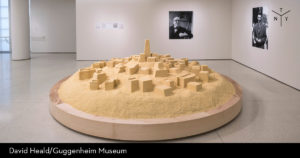
I wish I were in New York right now. At the Guggenheim, specifically. For there is an exhibit entitled But a Storm Is Blowing from Paradise: Contemporary Art of the Middle East and North Africa. Within this exhibition that features photographs, sculptures, videos, and more, is an installation piece by Berlin-based Algerian artist Kader Attia, “Untitled (Ghardaïa)” depicting the the M’zab hilltop fortress Ghardaïa – all made from couscous.
From the Guggenheim website, this is third exhibition of the Guggenheim UBS MAP Global Art Initiative, and illuminates contemporary artistic practices in the Middle East and North Africa and the region’s diaspora. Presenting a selection of newly acquired works for the Guggenheim’s permanent collection, this exhibition will feature installations, photographs, sculptures, videos, and works on paper from a broad selection of artists. The exhibition is curated by Sara Raza, Guggenheim UBS MAP Curator, Middle East and North Africa. Following its presentation in New York, But a Storm Is Blowing from Paradise will travel to Istanbul’s Pera Museum in 2017.
From the New Yorker article by Julie Belcove, “He chose couscous as his medium because the dish is more than a thousand years old, predating the Arabs and modern Europeans who invaded the region, and because it transcends religion, serving as a staple not only in Muslim homes but at the Shabbat dinners of North African Jews. Couscous also bears a nifty resemblance to sand, and the work-in-progress could have passed for an elaborate sandcastle. At the center of a circular platform rose a yellowish minaret, surrounded by squat houses with sloping walls, rounded parapets, and roofs topped by domes. Attia said he was amazed to learn that Le Corbusier visited Ghardaïa in the nineteen-thirties and was captivated by its minimalism and its community-oriented urban plan, lessons that he and his fellow-modernist Fernand Pouillon applied to the apartment blocks they later built in France, which now house North African immigrants.”